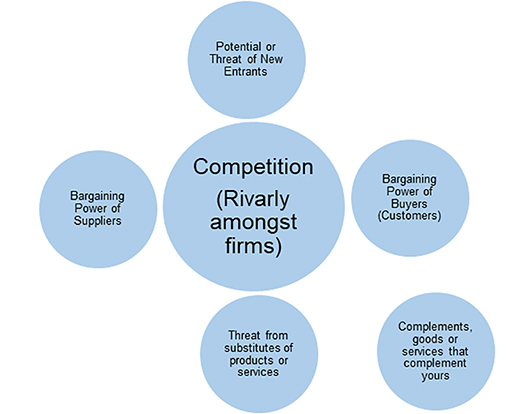1.1 Porter’s Five Forces
‘Porter’s Five Forces’ (Porter, 2008) is often used to assess the rivalry in any given market as a clue to how you need to position yourself.
For example, as the new entrant, you might use this to assess an existing market. If you wanted to set up a coffee shop, the cost of entering the market might be low (depending on location), but you might think carefully about suppliers and in particular discounts and credit. However, you would probably be most concerned about threats of substitution and buyer power as many of the coffee chains have become established and others have branched into the lifestyle business – working space or healthy alternatives to coffee, such as chai-based beverages, juice bars and so on.
You might also start to think about complements. Coffee and books, for example, seem to be a staple on the high street now, and more than one independent has evolved from one form of outlet to another one – with a café or internet café or bookshop with café – over the last 20 years.
Enterprises need to reflect the outside world and how it is changing. If you have not used STEEPLE, Porter’s Five Forces or other similar scanning tools, you can try now to see what results you would get when you apply them.
Activity 1 How useful is the theory in practice?
- Thinking of your own business idea or enterprise, make some notes using either or both of the scanning tools mentioned above, or another one you may be familiar with.
- Having tried to use either STEEPLE or Porter’s Five Forces, how useful did you find them?
Discussion
Focusing on the rapidly changing external environment alone can leave us wondering how to respond, i.e. nobody actually tells you what to do. That is something you still have to work out for yourself. One criticism of such techniques is that if you spend a lot of time worrying about what others are doing, who is worrying about what you are doing? Another is that the analysis is only a snapshot in time – the environment changes sometimes quite rapidly, or parts of it do. How often will you repeat the analysis? Finally, who decides which issues or challenges are more or less important? The answer of course is you!
Despite these criticisms, if the alternative is to never think of the external factors and how they could impact on your enterprise, it may be that, like the meteor heading for Earth in Figure 1, you can’t see the trouble heading your way – and it could be damaging!
By being concerned about how you create value and about the unique way you compete, this will lead to greater diversity as every individual or group will have a different set of resources and capabilities. This session focuses on that approach. Before looking at it in detail, you will first need to develop a clearer view of what happens within an enterprise. In the next sections you will consider what kinds of transformation processes occur.

